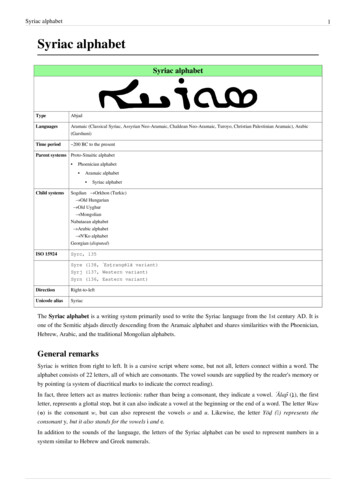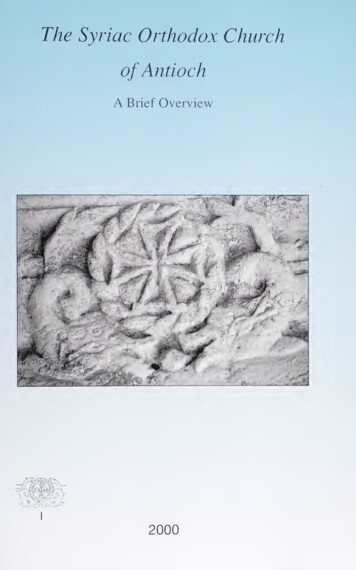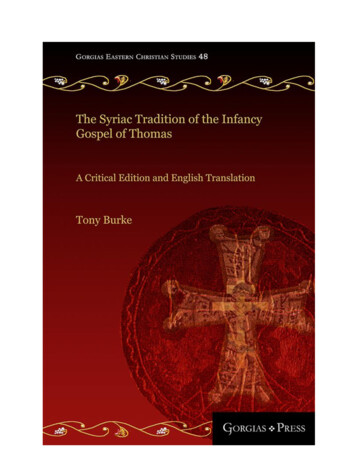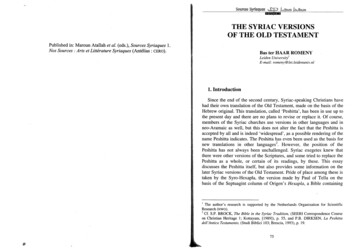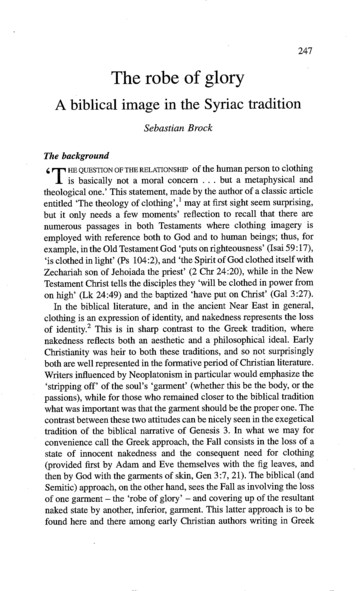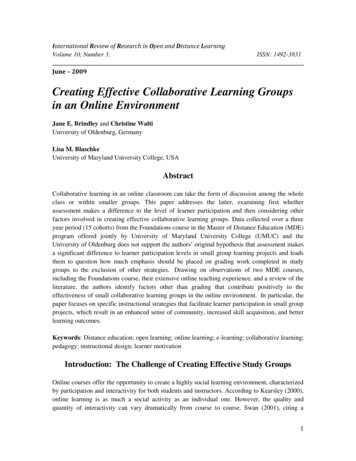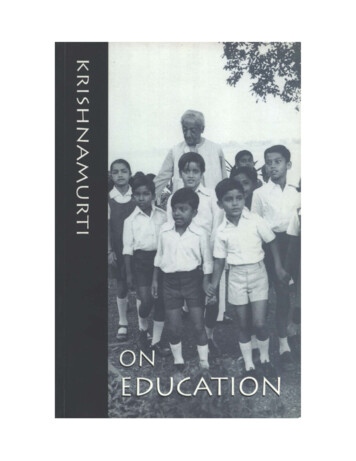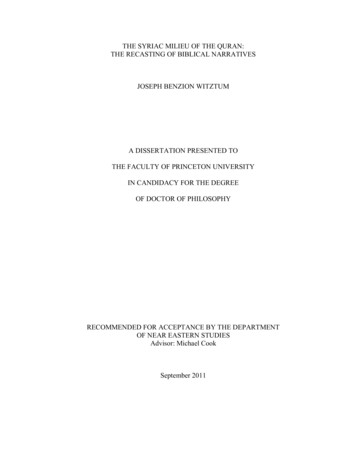
Transcription
THE SYRIAC MILIEU OF THE QURAN:THE RECASTING OF BIBLICAL NARRATIVESJOSEPH BENZION WITZTUMA DISSERTATION PRESENTED TOTHE FACULTY OF PRINCETON UNIVERSITYIN CANDIDACY FOR THE DEGREEOF DOCTOR OF PHILOSOPHYRECOMMENDED FOR ACCEPTANCE BY THE DEPARTMENTOF NEAR EASTERN STUDIESAdvisor: Michael CookSeptember 2011
5. Jewish Cain, Muslim Abel15.1. IntroductionIn the previous chapter I examined a Quranic retelling of a Hebrew Bible narrativewhich Geiger considered to be an exception to the rule in that it exhibited Christianinfluence. Having established that the Quranic episode of Adam’s fall is in fact closer tothe (Syriac) Christian tradition than Geiger believed, I now turn to study stories that toGeiger were evidently of a Jewish origin. In this chapter as well as the following ones Iwill argue that the Syriac Christian tradition helps illuminate these retellings too. To do soI will look at three examples, the first of which is the Cain and Abel story.Within the Syriac tradition I shall focus primarily on dramatic poems which expandon Biblical themes and range from formal dialogues in alternating stanzas to dramatizednarratives which include dialogue and homiletic material.2 That the Quran should beaware of them is not entirely surprising bearing in mind their use in liturgy and wideaudience.3 Indeed the Qur’ānic retellings and the Syriac poems display similarities withregard to motifs, literary form, lexical use, and typological function.5.2. The textsIn Genesis 4 we read as follows:(1) Now the man knew his wife Eve, and she conceived and bore Cain, saying: “I haveproduced a man with the help of the Lord”. (2) Next she bore his brother Abel. Now Abelwas a keeper of sheep, and Cain a tiller of the ground. (3) In the course of time Cain1An early version of this chapter was presented at the X Symposium Syriacum, Granada, September 2008.S. Brock, “Dramatic Dialogue Poems”, in H. J. W. Drijvers et al. (eds.), IV Symposium Syriacum 1984(Rome, 1987), 135-47; id., “Syriac Dialogue Poems: Marginalia to a Recent Edition”, Le Muséon 97(1984): 29-58.3For the wide diffusion of these homilies, see L. Van Rompay, “The Christian Syriac Tradition ofInterpretation”, in M. Sæbø (ed.) Hebrew Bible / Old Testament: The History of Its Interpretation(Göttingen, 1996), 641; K. Upson-Saia, “Caught in a Compromising Position: The Biblical Exegesis andCharacterization of Biblical Protagonists in the Syriac Dialogue Hymns”, Hugoye 9.2 (2006).2111
brought to the Lord an offering of the fruit of the ground, (4) and Abel for his partbrought of the firstlings of his flock, their fat portions. And the Lord had regard for Abeland his offering, (5) but for Cain and his offering he had no regard. So Cain was veryangry, and his countenance fell. (6) The Lord said to Cain: “Why are you angry, and whyhas your countenance fallen? (7) If you do well, will you not be accepted? And if you donot do well, sin is lurking at the door; its desire is for you, but you must master it”.(8) Cain said to his brother Abel, and when they were in the field, Cain rose up against hisbrother Abel and killed him. (9) Then the Lord said to Cain: “Where is your brotherAbel?” He said: “I do not know; am I my brother’s keeper?” (10) And the Lord said:“What have you done? Listen; your brother’s blood is crying out to me from the ground!(11) And now you are cursed from the ground, which has opened its mouth to receiveyour brother’s blood from your hand. (12) When you till the ground, it will no longeryield to you its strength; you will be a fugitive and a wanderer on the earth”. (13) Cainsaid to the Lord: “My punishment is greater than I can bear! (14) Today you have drivenme away from the soil, and I shall be hidden from your face; I shall be a fugitive and awanderer on the earth, and anyone who meets me may kill me”. (15) Then the Lord saidto him: “Therefore whoever kills Cain will suffer a sevenfold vengeance”. And the Lordput a mark on Cain, so that no one who came upon him would kill him. (16) Then Cainwent away from the presence of the Lord, and settled in the land of Nod, east of Eden.4In the Quran we read:(27) Recite to them the story of the two sons of Adam truthfully when they offered anoffering (qarrabā qurbānan) and it was accepted (fa-tuqubbila) from one of them andwas not accepted (wa-lam yutaqabbal) from the other. [The one whose offering was notaccepted] said: “I will surely kill you (la-aqtulannaka)”. [His brother] said: “Allahaccepts [offerings] only from the God-fearing. (28) If you extend your hand against me tokill me (la-in basaṭta ilayya yadaka li-taqtulanī), I will not extend my hand against you tokill you. Indeed I fear God, the Lord of all. (29) Indeed I desire (innī urīdu)5 that you bearmy sin and your sin (an tabū’a bi-ithmī wa-ithmika)6 so that you become one of the4NRSV slightly adapted to fit the Hebrew text.The exegetes were troubled by Abel’s wish that Cain sin (See Fakhr al-Dīn al-Rāzī, al-Tafsīr al-kabīr,11:207). An interesting yet artificial solution was to read annā urīdu (“How could I wish ”) instead of innīurīdu (“I wish ”) which leaves the rasm intact, changing only the vocalization; al-Khaṭīb, Mu‛jam alqirā’āt, 2:258.6Abel’s utterance is problematic. What is his own sin and why should Cain bear it? In al-Ṭabarī, Jāmi‛ albayān, 8:330-33, the following explanations are cited: that Cain bear the sin of killing Abel in addition to5112
inhabitants of the Fire; that is the reward of the evildoers (al-ẓālimīna)”. (30) But his soulincited him to kill his brother so he killed him and thus became one of the lost. (31) ThenAllah sent a raven digging up the earth (yabḥathu fī l-arḍi) in order to show him how toconceal his brother’s corpse (li-yuriyahu kayfa yuwārī saw’ata akhīhi).7 He said: “Woe isme. Am I unable to be like this raven and conceal my brother’s corpse?” He then becameone of those who pity themselves (fa-aṣbaḥa mina l-nādimīna).8 (32) On account of thishis other sins, taking ithmī as ithm qatlī; that Cain bear Abel’s sin in addition to his own sin in murderinghis brother. The latter approach is fine-tuned in al-Zamakhsharī, al-Kashshāf, 1:658-59, where the idea isthat Cain should bear his own sin in killing Abel and the equivalent of Abel’s sin were he to kill Cain, therationale for this being that the instigator is responsible for the defensive actions of the attacked party.Another interpretation cited in Fakhr al-Dīn al-Rāzī, al-Tafsīr al-kabīr, 11:207, is based on a tradition thaton the day of resurrection wrongdoers who will not be able to appease those whom they wronged otherwisewill take some of their sins off their hands. See also al-Qurṭubī, al-Jāmi‛, 7:414-15. The Quranic view ofpersonal responsibility is not entirely clear. Whereas several verses repeat that “no bearer of burdens shallbear another’s burden” (Q 6:164, Q 17:15, Q 35:18, Q 39:7, Q 53:38), other verses present a murkier stateof affairs. In Q 16:25, the unbelievers are said to carry their own burdens fully on the day of resurrection aswell as “some of the burdens of those that they lead astray without any knowledge”. In Q 29:12-13, theunbelievers attempt to seduce the believers to join them with a promise to bear their sins. The Quran deniesthat they shall bear any of the believers’ sins and then adds: “They shall certainly carry their loads and otherloads along with their loads ”. What these other loads are remains unspecified. It seems that Q 5:29 isanother example of a more complicated concept of responsibility.7The meaning of saw’a is debated. It might be best to understand it as “any disgracing action or thing”; seeLane, Arabic-English Lexicon, 1:1458. Following the context some exegetes understand it as “corpse”(jīfa). Others render it as “genitals” (‛awra); see, e.g., Fakhr al-Dīn al-Rāzī, al-Tafsīr al-kabīr, 11:209.Though the exegetes do not spell it out, the source for the genitals interpretation is in a striking parallelpassage in Q 7:20-27. There Satan leads Adam and Eve astray in order to “to reveal (li-yubdiya) to themthat which was hidden (wūriya) from them of their shameful parts (saw’ātihimā)” (Q 7:20). Addressing itsaudience, the Quran reminds the children of Adam that God sent down to them “a garment to hide yourshameful parts (libāsan yuwārī saw’ātikum) and feathers” (Q 7:26). The Quran draws the lesson to belearned from this story: “Children of Adam! Let not Satan tempt you as he brought your parents out of theGarden, stripping them of their garments to show them their shameful parts (li-yuriyahumā saw’ātihimā)”(Q 7:27). The only other passage in which saw’a occurs is Q 20:121, again with reference to Adam andEve’s nakedness. Likewise, w-r-y in the third form is used only in these two stories. The use of similarlanguage in both narratives suggests that the language and themes of the one may have influenced the other.Already in the Biblical text the two stories which appear in consecutive chapters parallel each other inseveral ways. Compare, for example, God’s curse of Eve, “[ ] yet your desire shall be for your husbandand he shall rule over you” (Genesis 3:16), with His consolation to Cain, “[ ] its desire is for you, but youmust master it” (Genesis 4:7); God’s questions to Adam and Eve, “Where are you?” (Genesis 3:9) and“What is this that you have done?” (Genesis 3:13), with His questions to Cain, “Where is your brotherAbel?” and “What have you done?” (Genesis 4:9-10); and the curse concerning the ground in Genesis 3:17with that in Genesis 4:11. It is not therefore surprising that in post-Biblical times the similarities betweenthe two episodes continued to grow. Q 5:31 might reflect another instance of this process. In a mirror imageof the Adam and Eve story in which a snake brought about their nakedness which required that God helpthem cover it, in the retelling of the Cain and Abel story a raven sent by God teaches Cain how to cover hisbrother’s nakedness/corpse. Whether the influence was restricted to phraseology or perhaps accounts for theorigin of the burial motif in the Cain story remains to be seen (see also Genesis 3:19: “[ ] until you returnto the ground you are dust and to dust you shall return”). An interesting precedent for the Quranic linkingof Genesis 3 and 4 is found in the Syriac Life of Abel where in his plea to Cain, Abel says: “by Him whostripped Adam of the glory he was clothed in, do not take off from my limbs my clothes and reveal to thesun in the sky the nakedness (pursāyā) of my youth”; S. Brock, “A Syriac Life of Abel”, Le Muséon 87(1974): 476. Though pursāyā is not found in the Peshitta to Genesis 3, it is used to describe Adam andEve’s nakedness in later Syriac texts (see, e.g. Ephrem’s Commentary on Genesis 2.21-22 and 27).Interestingly, one of the Arabic words used to gloss pursāyā is saw’a; Payne Smith, Thesaurus Syriacus,2:3277.8For this translation of nādimīna, see the discussion below.113
(min ajli dhālika) We decreed to the Children of Israel (katabnā ‛alā banī isrā’īla) thatwhoever kills a soul – not [in retaliation for another] soul nor for corruption in the land9 –shall be as if he killed all mankind; and whoever gives life to a soul shall be as if he gavelife to all mankind. Our messengers have already come to them with clear signs, but manyof them indeed commit afterwards excesses in the land (Q 5:27-32).10The Quran departs from the Biblical version in several ways. Many details areomitted: the protagonists are simply “the two sons of Adam” (ibnay ādama) and nofurther names are given;11 their occupations and specific offerings are not mentioned; thedialogue between God and Cain is lacking and so on. But omissions of this kind arecharacteristic of Quranic retellings, which after all were trying to drive home a pointrather than repeat stories in their entirety.More interesting are those elements of the plot which are not found in the Bible.Striking are the dialogue between the brothers in which Abel presents an extremelypassive approach,12 the burial scene and the decree which follows the story. Can thesedepartures from the Biblical story tell us whence the Quran took its version?9The translation follows the predominant reading aw fasādin. According to al-Ḥasan al-Baṣrī’s reading awfasādan, the verse should be rendered “[ ] that whoever kills a soul – not [in retaliation for another] soul –or [commits] corruption in the land shall be as if he killed all mankind”; al-Qurṭubī, al-Jāmi‛, 7:429, and alKhaṭīb, Mu‛jam al-qirā’āt, 2:264.10Studies devoted to this episode in the Quran, primarily in light of later Islamic tradition, include W. BorkQaysieh, Die Geschichte von Kain und Abel (Hābīl wa-Qābīl) in der sunnitisch-islamischen Überlieferung(Berlin, 1993), and I. Zilio-Grandi, “La figure de Caïn dans le Coran”, Revue de l’histoire des religions 216(1990): 31-85.11Whereas the vast majority of exegetes recognized the story of Cain and Abel in this passage, al-Ḥasan alBaṣrī (d. 728) and al-Ḍaḥḥāk (d. 723f) both argue that the two protagonists were not Adam’s immediatesons, but rather were two Israelites, who were like all of humanity children of Adam. The motivation forthis interpretation is found in v. 32, where God decrees to the Children of Israel that whoever kills a soulshall be as if he killed all mankind. If the consequences of the sin affect the Children of Israel, it must havebeen committed by Israelites. Moreover, the story is related with the intent of highlighting Israelitejealousy; al-Ṭabarī, Jāmi‛ al-bayān, 8:324-25; Fakhr al-Dīn al-Rāzī, al-Tafsīr al-kabīr, 11:204. As we shallsee later, in the Christian tradition Cain is said to be the father of the Jews.12My characterization of the Quranic Abel as passive refers only to the fact that he abstained fromphysically defending himself. Spiritually, his behavior was brave and full of strength. I use passivity in asimilar manner to describe Abel’s conduct according to the Syriac sources.114
5.3. Jewish origin?To Geiger it is evident that the Quranic retelling “is depicted for us quite in itsJewish colours”, by which he means that the story follows rabbinic traditions.13 Hisconclusion is based on three parallels, though closer scrutiny suggests that the matter ismore complicated than he assumes. Let us first examine the parallels he adduces.5.3.1. The dialogueThe first concerns the dialogue held between the brothers before the murder. Nonexistent in Genesis, such a dialogue is found in the Quran (vv. 27-29) and the PalestinianTargums. But as Geiger himself concedes “the matter of the conversation is given sodifferently in each case that we do not consider it worthwhile to compare the twopassages more closely”.14 We shall return to examine the dialogues shortly.5.3.2. The ravenThe second parallel is shows greater similarity of detail and concerns the Quranicembellishment that Cain learned how to bury Abel by observing the practice of a raven(v. 31). A similar motif is recorded in a few rabbinic texts.15 Geiger cites PRE 21:Adam and his helpmate were sitting and weeping and mourning for him, and they did notknow what to do with Abel, for they were unaccustomed to burial. A raven, one of whosefellow birds had died, came, took its fellow, dug in the earth and buried it before theireyes. Adam said: “Like this raven I will act”. He took the corpse of Abel and dug in theearth and buried it. The Holy One, blessed be He, gave a good reward to the ravens in this13Geiger, Judaism and Islam, 80. His arguments are reproduced in Tisdall, The Original Sources of theQur’ān, 62-66. For an apologetic yet at times useful response, see M. S. M. Saifullah et al., “On theSources of the Story of Cain & Abel in the Qur’an”, available online BCandA.html14Geiger, Judaism and Islam, 80.15The most comprehensive studies of this motif are H. P. Rüger, “Das Begräbnis Abels: Zur Vorlage vonSure 5,31”, Biblische Notizen 14 (1981): 37-45, and Ch. Böttrich, “Die Vögel des Himmels haben ihnbegraben”: Überlieferungen zu Abels Bestattung und zur Ätiologie des Grabes (Göttingen, 1995).115
world. What reward did He give them? When they bear their young and see that they arewhite they flee from them, thinking that they are the offspring of a serpent, and the HolyOne, blessed be He, gives them their sustenance without lack. Moreover, they call out thatrain should be given upon the earth, and the Holy One, blessed be He, answers them, as itis said: “He gives to the beast its food, and to the young ravens which cry”.16When Geiger wrote his study, it was still possible to believe PRE to be pre-Islamic.However, since then it has been demonstrated that PRE is clearly a post-Quranic midrashwhich at times reflects Islamic traditions so that we can no longer be sure which traditioninfluenced the other in this case.17Other scholars traced the Quranic motif to the Tanḥuma.18 In Tanḥuma Bereshit10 we read:After Cain slew Abel, he [ Abel] was cast to the ground and Cain did not know what todo. Thereupon, the Holy One, blessed be He, summoned for him two clean birds and oneof them killed the other, dug with its talons and buried it. Cain learned from it what to do.He dug [a grave] and buried Abel. It is because of this that birds are privileged to havetheir blood covered.19As in the Quran, in this version it is Cain who buries Abel not Adam. Unlike theQuran which mentions a raven, in the Tanḥuma we find “two pure birds”. Their purity isnoted presumably in preparation for their reward, the covering of their blood with soil,16Geiger, Judaism, 80. ET adapted from G. Friedlander, Pirḳê de Rabbi Eliezer (New York, 1981), 156-67.It should be noted that earlier in the same chapter we are told that Cain dug and buried Abel’s body in theground so as to conceal his sin, though in the Yalquṭ’s quotation from PRE he hides it in the field withoutdigging.17For the provenance of PRE in eighth or ninth-century Palestine and its awareness of Islamic legends, seechapter 2.1. That this is the case in the ravens tradition is assumed in V. Aptowitzer, Kain und Abel in derAgada, den Apokryphen, der hellenistischen, christlichen und muhammedanischen Literature (Vienna,1922), 54. Cf. Böttrich, “Die Vögel des Himmels haben ihn begraben”, 53-56, where it is argued that otherreasons besides Islamic influence may have caused the raven to enter the Cain legend.18See Sidersky, Les origines des légendes musulmanes, 18. His reasoning in preferring the Tanḥuma overPRE was based on content rather than on issues of dating. See also Speyer, Die Biblischen Erzählungen, 86,and D. Masson, Monothéisme coranique et monothéisme biblique (Paris, 1976), 336.19A freer and more elegant translation is found in S. A. Berman, Midrash Tanhuma-Yelammedenu: AnEnglish Translation of Genesis and Exodus from the Printed Version of Tanhuma-Yelammedenu with anIntroduction, Notes, and Indexes (Hoboken, 1996), 31-32.116
applicable only to pure birds (Leviticus 17:13).20 Mirroring Cain, the bird first murders itsfriend and then buries it.21 For Stillman “the qur’anic version is merely an epitome” of theTanḥuma.22 But this is not necessarily the case, seeing that the Tanḥuma most probablyfinished evolving long after the Quran appears.23 That this passage might belong to laterstrata of the Tanḥuma is suggested by its not occurring in the parallel text known as theBuber Tanḥuma.24 The emphasis on the birds’ purity might also be a reaction to theQuranic story, stressing that the birds were not impure ravens. Most importantly, as weshall argue later, the Quran preserves a more basic form of the legend in that all the ravendoes there is dig with no mention of killing or burying another bird.The theme is also found in a Targumic tosefta to Genesis 4:8 (Oxford BodleianMs. Heb. c 74r):And he (i.e. Cain) did not know where to strike him. He looked about here and there, untilhe saw two birds fighting; and one rose up against the other, and struck it on its mouth,and its blood spurted out until it died.25 Cain took a lesson from it, and did the same toAbel [his] brother. Then seeing that he was dead, he feared that his father would demand20“And anyone of the people of Israel, or of the aliens who reside among them, who hunts down an animalor bird that may be eaten shall pour out its blood and cover it with earth”.21Note the correspondence between the figure that buries Abel and the question of how the dead bird died.In PRE Adam learns from a raven which buries an independently dead raven, whereas in the Tanḥuma Cainfollows the example of a bird which kills its fellow and then buries it.22Stillman, “The Story of Cain and Abel”, 236.23For the dating of the Tanḥuma see chapter 2.1. Regarding our passage scholars are divided. Whereas inBöttrich, “Die Vögel des Himmels haben ihn begraben”, 34-40, it is treated as the earliest Jewishattestation of the bird tradition, in Rüger, “Das Begräbnis Abels”, 44, it is thought to be based on acombination of PRE and the passage which appears in the printed editions of Genesis Rabba, but is notfound in any of the manuscripts (treated below).24For a similar principle, see M. Bregman, The Tanhuma-Yelammedenu Literature: Studies in the Evolutionof the Versions (Piscataway, 2003), 184-86 (in Hebrew). Bregman’s examples concern parallel passages inthe two versions of the Tanḥuma where the regular Tanḥuma has an additional sentence which is unattestedin the Buber Tanḥuma. This is not the case in our example since the entire passage about the two birds hasno parallel in the Buber Tanḥuma.25I follow Klein here, though the mouth as the most vulnerable organ is odd. It might be preferable tointerpret the text otherwise. The sentence ולא הוה ידע ב]מה[ ימחיניה could also be rendered “And he did notknow with what to strike him”. In the same manner, ומחיהי בפומיה might mean “and struck it with its mouth(i.e. beak)”. This interpretation is supported by the killer bird later digging a hole with its beak ( והוא נקיט )בפומיה וחפר . If correct, this would mean that Cain killed Abel with his teeth, an extremely savage portrayal.Such a tradition is indeed known from several sources; see Aptowitzer, Kain und Abel, 51 and 154, note219b (where the Targumic passage is cited and translated as I have suggested).117
[Abel] from him; and he did not know what to do. Looking up, he saw the bird that hadkilled its fellow putting its mouth to the ground; and it dug [a hole], and buried the otherdead one, and covered it with earth. At that moment, Cain did the same to Abel, so that[his father] might not find him.26It is hard to firmly date this passage.27 Here the birds serve as role models not only for theburial but for the murder as well.28 Note also that Cain’s motive for the burial is to avoidgetting caught by Adam. In all the other sources the burial is presented as a positive actinspired by God (Quran, Tanḥuma) and worthy of reward (Tanḥuma, PRE).Another variant on this theme is found in the printed editions of Genesis Rabba22.8. It is hard to know where this particular passage originated from. It clearly does notbelong to the original text as it is unattested in all the manuscripts.29 It is attributed toGenesis Rabba also in the printed editions of Yalquṭ Shim‛oni, a twelfth or thirteenth-26M. L. Klein, Genizah Manuscripts of Palestinian Targum to the Pentateuch (Cincinnati, 1986), 1:12 (ET)and 13 (text). The text was first published in an appendix in M. Ginsburger, Das Fragmententhargum(Berlin, 1899), 71-72. The language of the passage was partly inspired by Exodus 2:11-12 (“One day, afterMoses had grown up, he went out to his people and saw their forced labour. He saw an Egyptian beating aHebrew, one of his kinsfolk. He looked this way and that, and seeing no one he killed the Egyptian and hidhim in the sand”; see M. L. Klein, “Targumic Studies and the Cairo Genizah”, in S. C. Reif (ed.), TheCambridge Genizah Collections: Their Contents and Significance (Cambridge, 2002), 58. Another possibleinspiration for this passage may have been Adam’s hiding from God in Genesis 3.27The manuscript dates from the mid-11th to the late 14th century; Klein, Genizah Manuscripts, XXXVII.This, however, tells us little about the date of the work itself. Klein does not date the Targumic toseftot andmakes do with the observation that vestiges of an original Palestinian dialect survive in them; ibid., XXVII.Böttrich’s argument for an early date of the Tosefta on Cain and Abel is founded on an unfortunateoversight. He notes the correspondence of our Tosefta with the quotation found in Aptowitzer, Kain undAbel, 154 note 219b, which he believes to stem from the Fragment Targum. Since he dates the FragmentTargum to the first or second century this proves that the tradition is ancient; Böttrich, “Die Vögel desHimmels haben ihn begraben”, 46. The citation in Aptowitzer stems, however, from the first publication ofthe very same manuscript published by Klein. Böttrich’s dating is based then on comparing the manuscriptto itself! This error is crucial for his early dating of the tradition.28Jacob ben Asher (d. 1343) in his commentary on the Torah also knows of a tradition that Cain learnedhow to kill from observing one raven kill another; see Böttrich, “Die Vögel des Himmels haben ihnbegraben”, 46-47. The late date notwithstanding, Rüger argues that the midrash preserved by Jacob benAsher was the Vorlage of Q 5:31; Rüger, “Das Begräbnis Abels”, 44-45. See the responses in A. Ulrich,“Zum ‘Begräbnis’ Abels”, Biblische Notizen 15 (1981): 48-54, and Böttrich, ibid.29See Theodor and Albeck, Midrash Bereshit Rabba, 1:215. Neither Rüger nor Böttrich notes that thepassage is unattested in the manuscripts; Rüger “Das Begräbnis Abels”, 38, and Böttrich, “Die Vögel desHimmels haben ihn begraben”, 40-41. It is also noteworthy that Genesis Rabba 22.10 assumes that Abelhad not yet been buried (“It [the soul] could not ascend above, because no soul had yet ascended thither; norcould it go below, because Adam had not yet been buried there; hence the blood lay spattered on the treesand the stones”; ET adapted from Freedman, Midrash Rabbah: Genesis, 1:189).118
century midrashic thesaurus on the Bible, but again not in the Oxford manuscript(Bodleian 2637) of the Yalquṭ.30And who buried him? Rabbi Elazar ben Pedat said: “The birds of the air and the pureanimals buried him and God gave them their reward, the two blessings uttered over them,one on the slaughter and one on the covering of the blood”.Here rather than serve as a role model, the wildlife itself buries Abel. In having both birdsand animals participate in the burial, this passage answers a difficulty created by thetradition as presented in the Tanḥuma. If the covering of the blood of birds was a rewardfor their part in the burial of Abel, how is the covering of the blood of animals to beexplained, seeing that Leviticus 17:13 prescribes the covering of both? Solution: bothbirds and animals buried Abel.Since the bird tradition is found in several rabbinic sources and versions it is hardto deny the possibility that ultimately its origin is indeed Jewish. Nonetheless, four pointsare noteworthy. First, the tradition is found in Christian sources as well, though again it ismost difficult to date these traditions.31 Second, none of these Jewish or Christian texts30On the Yalquṭ Shim‛oni, see Stemberger, Introduction to the Talmud and Midrash, 351-52. Our passage isin the Yalquṭ Shim‛oni Genesis remez 38. For the Oxford manuscript reading, see D. Hyman et al. (eds.),Yalkut Shim‛oni ‛al ha-Torah le Rabbenu Shim‛on ha-Darshan, (Jerusalem, 1973), 1:127.31In 2 Enoch 71:36 we read: “And in connection with that archpriest it is written how he will also beburied there, where the center of the earth is, just as Adam also buried his own son there – Abel, whom hisbrother Cain murdered; for he lay for 3 years unburied, until he saw a bird called Jackdaw, how it buried itsown young”; F. I. Andersen, “2 (Slavonic Apocalypse of) ENOCH”, in OTP, 1:208. This verse is attestedonly in the longer recension of 2 Enoch and is usually assumed to be an interpolation, the dating of which isno easy task. Whereas Vaillant postulates that the passage was added by a redactor working sometime in the13th-16th centuries, Böttrich dates it to the fourth to seventh centuries; Böttrich, “Die Vögel des Himmelshaben ihn begraben”, 111-14. Böttrich’s dating is based on his assumption concerning the date of therabbinic parallels. For Georgian, Turkish, Slavic, Finnish and Estonian traditions, all attested in late works,see ibid., 78-109. To this list should be added three Armenian works in which Cain learns his murdermethod from a demonic raven. The works are Abel 3.4 (“And whence did he know? Two demons in theform of ravens quarreled, and one, taking the flint, slaughtered his fellow. From this [Cain] learned, andhaving found [a stone], he slaughtered him bloodily. And he was buried by his parents”), History of theForefathers 25 (“But half say that Satan disguised himself in the likeness of two ravens, and the one castthe other to the ground and slaughtered [it] with a flinty stone. Thus Cain did to Abel and killed him”), andAbel and Cain 27-28 (“Then Satan took on the form of two ravens, and the one took a sharp stone, and hestruck the other with it in the throat and killed him, and the stone was sharp as a razor. And Cain learned119
are definitely pre-Quranic.32 Third, the identification of the bird as a raven as opposed toa general reference to birds or pure birds seems more original, in that ravens were wellknown for their habit of digging caches to store food.33 Eventually the raven’s part wasperceived as meritorious (PRE). This contradicts the usual image of ravens and thereforethey were replaced with pure birds (Tanḥuma).34 Finally, a textual comparison of theQuranic version to the rabbinic and Christian parallels seems to support the primacy ofthe tradition as preserved in the Quran. Whereas in the parallel ver
Interpretation”, in M. Sæbø (ed.) Hebrew Bible / Old Testament: The History of Its Interpretation (Göttingen, 1996), 641; K. Upson-Saia, “Caught in a Compromising Position: The Biblical Exeges


